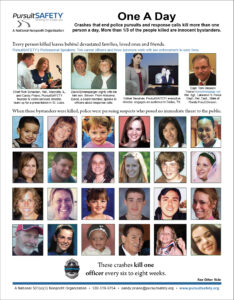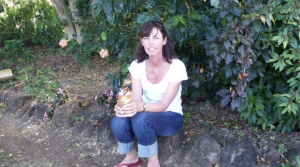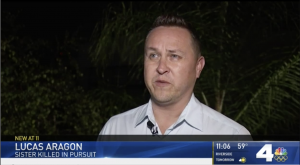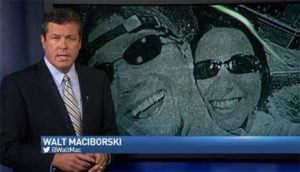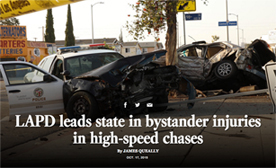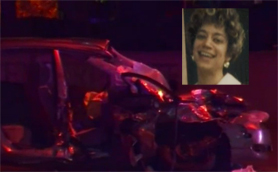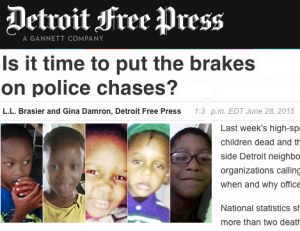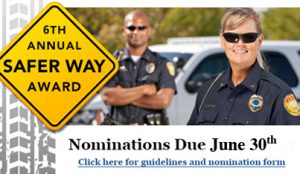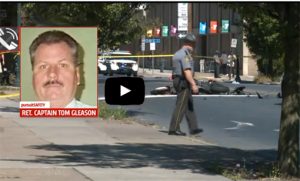PursuitSAFETY IN THE NEWS
-
Ventura County Star
Lucas Aragon, PursuitSAFETY’s media representative in Los Angeles provided great input into this excellent article:
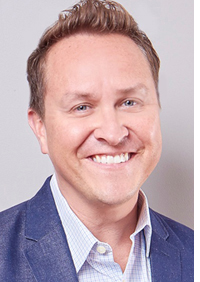
Police say pursuit policies are a balance between need and public safety by John Scheibe
One of the most dangerous things law enforcement officers engage in is pursuing a motorist who refuses to stop.
At least 11,506 people were killed during police chases across the nation from 1979 through 2013, according to the National Highway Transportation Safety Administration. …For the rest of the story, click here: Ventura County Star.
- CBS KEYE TV in Austin
- L.A. Times
- The Press Enterprise
- Detroit Free Press
- Safer Way Award
-
SF Chronicle
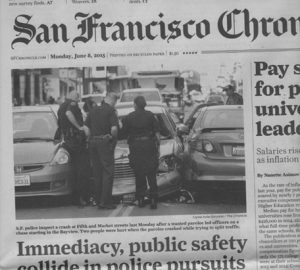
Are police chases too dangerous?
By Evan Sernoffsky
San Francisco Chronicle
June 6, 1015Three times in the past three months, suspects racing away from San Francisco police have plowed their cars into innocent people, killing a woman and sending several others to hospitals. Each time, officers apparently followed department policy. But in the aftermath of twisted metal and grief, a long-nagging question has re-emerged:
When, why and for how long should police chase bad guys fleeing in cars, especially in a densely populated city like San Francisco?
It’s that balance of risk versus reward. Was the pursuit necessary?
Was there an alternative way? —Candy PrianoPolice say sometimes chases are necessary, even if they can result in accidents, if society wants to keep dangerous felons off the street. Critics say authorities in many cases should hit the brake pedal as soon as lawbreakers hit the gas and start threading through traffic.
“Chases enhance the risk to the public in many cases,” said Candy Priano, executive director of PursuitSAFETY, a national nonprofit dedicated to changing law enforcement policy on high-speed pursuits. “Chasing is not a deterrent to crime. It has never lessened crime.
“It’s that balance of risk versus reward,” she said. “Was the pursuit necessary? Was there an alternative way?”
For Priano, the issue is deeply personal.
Thirteen years ago, a teenager who took her mother’s car without permission plowed into Priano’s minivan while being chased by police in Chico (Butte County). Her 15-year-old daughter, Kristie, who was on the way to a basketball game, was killed in the wreck.
“I don’t think time heals all wounds,” Priano said. “For me, it’s a matter of days or moments when I find peace. When Kristie was killed, the house became silent. She was the little spark plug of our family.”
Priano has dedicated the past decade-plus advocating for change on police-chase policies around the country. In 2005, she was a sponsor of Kristie’s Law, a state Senate bill that would have required all law enforcement officers in the state to chase after violent felons only. The bill didn’t pass — meaning each California jurisdiction still comes up with its own rules.
In San Francisco, police regulations say not to engage in high-speed pursuits of criminals they deem non-violent. The Police Department’s policy on pursuing fleeing violators says “when the risk appears to be unreasonable, or when specifically prohibited by this order, the supervisor shall immediately order the emergency response or pursuit terminated.”
SFPD officers gather evidence at the scene of a pursuit crash
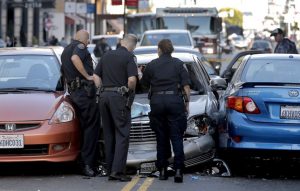
SF Crash Scene
And indeed, in three recent cases where civilians were hit, San Francisco police determined the suspects posed imminent threats to the public and never called off the chases.
Just last Tuesday night, a man fleeing officers in a BMW ran over a 19-year-old man in a crosswalk at Eighth and Mission streets, setting off an intense chase through the city and over the Bay Bridge before losing his pursuers. The victim was seriously injured and the fugitive is still on the loose.
“The suspect made a turn and immediately ran over the person,” San Francisco police spokesman Officer Albie Esparza said, explaining the police action. “The pursuit had not even begun. Clearly the suspect who chose to evade police was a violent felon.”
Esparza said when the city’s officers engage in a such high-speed pursuits, they have to evaluate the chase “on a continuous basis.”
- Broadcast on FOX 43
-
Esther Seoanes on AirTalk
Esther Seoanes, PursuitSAFETY’s executive director, shared her expertise about the dangers of vehicular police pursuit as a guest on AirTalk.
Click on Esther’s picture to listen to the 17-minute show. She comes on at about the 10:20-minute mark.

First Thomas Frank, reporter at USA Today, speaks about his national analysis on police chases. Then Travis Yates, commander with the Tulsa (OK) Police Department and director of SAFETAC training for law enforcement, discusses the need to debate this issue.
Esther stated, “Overall technology is good, however, I think that officer training needs to be at the forefront. Officer education and training have to be number one. Also, the change to restrictive pursuit policies, so officers don’t have to pursue for nonviolent, non-felony crimes is important. That’s very important.”
She talked about how research proves that most suspects can be apprehended without pursuit. She listed several ways to keep the public safe. They included: Many suspects are arrested because of good detective work, rather than a chase. Police officers have other options. They can capture suspects by using:
1. unmarked cars to follow offenders and apprehend them when they are no longer in the vehicle, i.e., when it’s safer for the officer and the public
2. two-way radios and interagency communication, and
3. variations of “auto trap” to catch drivers in stolen cars.Travis Yates stated that Esther “is onto something being done in other countries.” He said law enforcement in Canada, for example, use unmarked vehicles to follow suspects inconspicuously, and they pursue for only violent crimes.
Our four top media spokespersons:
Ret. Captain Tom Gleason
Advisory Board Member
Tallahassee, Florida
Cell: (850) 251-9983
Email: thomasgleason@comcast.net
Mark Priano
Board Member
Formerly resided in Indiana and Chicago; lives in Chico, California
Cell: (530) 513-1340
Esther Seoanes
Executive Director
Austin, Texas
Cell: (512) 351-0289
Email: esther@pursuitsafety.org
About Esther Seoanes
Bilingual: English & Spanish
Lucas Aragon
Media Representative
Los Angeles, California
Cell: (323) 630-1525



